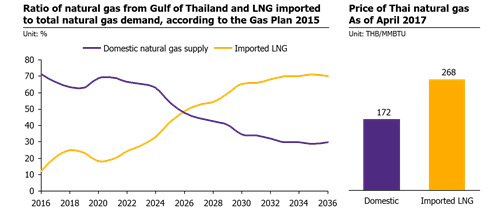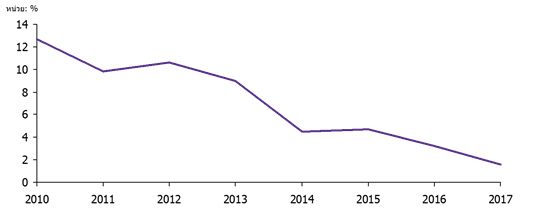Enhancing energy efficiency with new technologies
Nowadays the use of energy-saving products have become widespread, resulting in an increasing demand for related technologies. This is especially true for energy management system (EMS) for building and factories, which have been developed to function with energy-saving technologies. EMS can analyze energy usage in each building to optimize energy efficiency. This presents the industry with an opportunity to introduce the technology that enable consumers to better control their energy consumption. Energy service companies (ESCOs), who help their clients save energy costs and constantly refine their system can expect to see growth. EIC recommends ESCO operator to not overlook the market’s unique characteristics when developing a system, as different markets require different needs. This also includes consumers’ changing behaviors. These factors will be important in determining the growth of their business.
Author: Teerayut Thaiturapaisan

|
Highlight
|
The country’s average electricity price is expected to rise due to increasing natural gas prices which was reflected in the increase in electricity price in the past two adjustment periods. Currently, Thailand is heavily reliant on natural gas, with around 60% of electricity generation coming from natural gas power plant. According to Thailand’s 2015 Gas Plan, in 20 years, the country’s imported LNG will account for 70% of the country’s natural gas need, an increase from the current baseline of 20%. The increase in imported LNG (figure 1) will inevitably hike up electricity costs. Therefore, businesses are advised to prepare for increased costs by minimizing energy costs and maximizing energy efficiency. This can be done by using energy-saving technologies and enhancing the efficiency of energy management in buildings and factories.
The spread of energy-saving technologies will drive increase in demand for related technologies and systems. In recent years, many countries have turned attention to energy-saving technologies for domestic manufacturing activities. For example, India, a country that has been actively pushing for LED light bulbs to replace inefficient light bulbs. It has now replaced as many 253 million light bulbs, accounting for 33% of the total light bulbs used in the country (figure 2). As a result, the country’s peak power deficit has dropped by 10% in seven years (figure 3). Moreover, since LED light bulbs can be controlled through an electronic system, the entrepreneurs will find it desirable to develop an EMS that can communicate with LED light bulbs. For instance, Philips’ LEDGINE platform helps the manager of Gazprom service station in Romania to control in real time the light bulbs in the entire station through a mobile device. This helps reduce energy consumption in the gas station when there are no customers. Moreover, the technology is not limited to lighting, but also includes other activities in which energy-saving technologies can play an important role, such as smart thermostats, heating ventilation and air conditioning (HVAC), variable speed drive (VSD), or voltage vector control (VVC) that prevents energy loss (derating) in the motors of water pumps and manufacturing systems in plants.
Energy management system (EMS) in building and factories will be in greater demand in the future, thanks to a growing interest in energy efficiency. Factors that will contribute to the expansion of EMS includes: 1) Lower costs of Internet of Things (IoT) devices that will enable widespread installation of energy analytics devices in the building and factories. 2) “Green building” trends that will drive an increase in system integration between EMS and renewable system e.g. solar roof-top and energy storage system. 3) Businesses’ growing attention to personalization of consumer behavior, which will also necessitate a stronger need for EMS that can be developed to serve consumer. For example, Comfy, an energy management application, has been developed to analyze the optimal temperature in each zone of a building using data temperature preference data of each building occupant who input their desired temperature through the mobile app. Then, the application will learn and calculate the most suitable temperature using machine learning algorithms. This system can be applied to other businesses, e.g. hotels and restaurants, as it allows anyone in the building to adjust temperatures while saving energy consumption at the same time.
EIC views that an energy service company (ESCO), a service that can be developed to continually to help clients reduce energy costs, has a promising growth prospect. According to the EEP 2015, Thailand’s long-term energy plan, which sets as a target a reduction of 89,672 electricity consumption units, or around 300 billion Thai Baht, by 2039. This bodes well for the future of ESCOs who can select appropriate energy-saving technologies and continuously upgrade their systems to take advantage of new technologies, to optimize their customers’ energy consumption. Moreover, in developing the system, businesses are advised to take a broader look than simply reducing the electricity costs alone. ESCO operators should remember that it is important to have a system that makes the building environment pleasant. If the building serves the users well, the latter will be likely to repeat their visits. Such is an example of sustainable business practices.
|
|
|
|
|
Figure 1: Cost of electricity is expected to grow in proportion to the imported LNG ratio to Thailand’s natural gas demand

Source: EIC analysis based on data from the Energy Policy and Planning Office, Ministry of Energy.
Figure 2: Number of domestic LEDs installation in India in 2017

Source: EIC analysis based on data from Indian Ministry of Power
Figure 3: India’s peak power deficit between 2010 – 2017

Source: EIC analysis based on data from Indian Ministry of Power